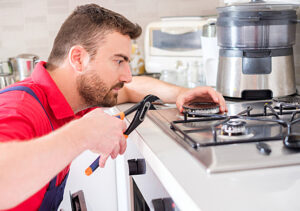Dishwashers have become an essential appliance in modern homes, making our lives easier by taking care of the tedious task of washing dishes. However, like any other appliance, dishwashers can experience problems and malfunctions over time. This is where dishwasher repair comes in. Instead of immediately replacing your dishwasher when it encounters issues, you can save time and money by attempting to repair it yourself.
Key Takeaways
- Dishwasher repair can save you money and extend the life of your appliance.
- Common dishwasher problems include leaks, strange noises, and failure to clean dishes properly.
- Tools and materials needed for dishwasher repair include a multimeter, screwdrivers, and replacement parts.
- Safety precautions such as turning off power and water supply should be taken before starting any repair work.
- Disassembling the dishwasher involves removing the front panel, control panel, and interior components.
Common Dishwasher Problems and Symptoms
There are several common problems that dishwashers can face. One of the most common issues is a dishwasher that doesn’t clean dishes properly. This can be caused by a clogged spray arm or a malfunctioning water inlet valve. Another common problem is a dishwasher that doesn’t drain properly, which can be caused by a clogged drain hose or a faulty pump. Other symptoms of dishwasher problems include leaks, strange noises during operation, and failure to start.
Tools and Materials Required for Dishwasher Repair
Before attempting to repair your dishwasher, it’s important to gather the necessary tools and materials. Some of the tools you may need include a screwdriver set, pliers, an adjustable wrench, and a multimeter for testing electrical components. You may also need materials such as replacement parts, such as a new pump or heating element, as well as cleaning supplies like vinegar or dishwasher cleaner.
Safety Precautions to Take Before Starting the Repair
Before starting any repair work on your dishwasher, it’s crucial to take safety precautions to protect yourself and prevent further damage to the appliance. First and foremost, make sure to disconnect the dishwasher from its power source by unplugging it or turning off the circuit breaker. Wear protective gloves and safety glasses to protect your hands and eyes from any potential hazards. It’s also important to read the manufacturer’s instructions and follow proper safety procedures specific to your dishwasher model.
Step-by-Step Guide to Disassembling the Dishwasher
To properly diagnose and repair your dishwasher, you will need to disassemble it. Here is a step-by-step guide on how to disassemble a typical dishwasher:
1. Start by removing the lower rack and any accessories inside the dishwasher.
2. Locate and remove the screws that hold the lower access panel in place.
3. Once the access panel is removed, you will have access to the pump and motor assembly.
4. Disconnect any electrical connections or hoses attached to the pump and motor assembly.
5. Remove any screws or clips that secure the pump and motor assembly to the dishwasher frame.
6. Carefully lift out the pump and motor assembly from the dishwasher.
Diagnosis and Repair of Dishwasher Pump and Motor Issues
One of the most common issues with dishwashers is problems with the pump and motor. If your dishwasher is not draining properly or making strange noises during operation, it may be due to a faulty pump or motor. To diagnose these issues, you can use a multimeter to test for continuity in the electrical connections. If there is no continuity, it indicates a problem with the pump or motor and they may need to be replaced.
To repair a faulty pump or motor, you will need to remove them from the dishwasher as mentioned in the previous section. Once removed, you can inspect them for any visible signs of damage or wear. If there are any broken or worn-out parts, they will need to be replaced with new ones. It’s important to consult your dishwasher’s manual or contact the manufacturer for specific instructions on how to replace these components.
Troubleshooting and Repair of Dishwasher Heating Element Problems
Another common issue with dishwashers is problems with the heating element. If your dishwasher is not heating up properly or leaving dishes wet after a cycle, it may be due to a faulty heating element. To troubleshoot this issue, you can use a multimeter to test for continuity in the heating element. If there is no continuity, it indicates a problem with the heating element and it may need to be replaced.
To repair a faulty heating element, you will need to access it by disassembling the dishwasher as mentioned earlier. Once you have located the heating element, you can remove it and inspect it for any visible signs of damage or wear. If there are any broken or worn-out parts, they will need to be replaced with a new heating element. Again, it’s important to consult your dishwasher’s manual or contact the manufacturer for specific instructions on how to replace the heating element.
Fixing Dishwasher Spray Arm and Water Inlet Valve Issues
Dishwasher spray arm and water inlet valve issues can also cause problems with the appliance’s performance. If your dishwasher is not cleaning dishes properly or not filling with water, it may be due to a clogged spray arm or a malfunctioning water inlet valve.
To fix a clogged spray arm, you can remove it from the dishwasher and clean it thoroughly. Use a toothpick or small brush to remove any debris or mineral deposits that may be blocking the spray holes. Once cleaned, reattach the spray arm and test the dishwasher to see if the issue has been resolved.
If your dishwasher is not filling with water, it may be due to a faulty water inlet valve. To diagnose this issue, you can use a multimeter to test for continuity in the electrical connections of the water inlet valve. If there is no continuity, it indicates a problem with the valve and it may need to be replaced. Consult your dishwasher’s manual or contact the manufacturer for specific instructions on how to replace the water inlet valve.
Reassembling and Testing the Dishwasher After Repair
Once you have completed the necessary repairs on your dishwasher, it’s time to reassemble it and test it to ensure it is working properly. Follow the reverse steps of the disassembly process to put the dishwasher back together. Make sure to securely attach any electrical connections, hoses, or screws that were removed during the disassembly.
After reassembling the dishwasher, run a test cycle to check if the repairs have resolved the issues. Pay attention to any unusual noises, leaks, or performance issues during the test cycle. If everything appears to be working properly, you can consider your dishwasher repair successful.
Preventive Maintenance Tips to Keep Your Dishwasher Running Smoothly
To prevent future issues with your dishwasher and keep it running smoothly, it’s important to perform regular maintenance. Here are some preventive maintenance tips:
1. Clean the dishwasher regularly by running a cycle with vinegar or a dishwasher cleaner.
2. Check and clean the spray arm and filter regularly to prevent clogs.
3. Inspect and clean the door gasket to ensure a proper seal.
4. Check and clean the drain hose and air gap to prevent clogs.
5. Avoid overloading the dishwasher and use the appropriate amount of detergent.
6. Regularly check for leaks or unusual noises during operation.
By following these preventive maintenance tips, you can extend the lifespan of your dishwasher and minimize the need for repairs.
Dishwasher repair is a cost-effective and practical solution for addressing common issues with your appliance. By understanding common problems and symptoms, gathering the necessary tools and materials, taking safety precautions, and following a step-by-step guide, you can successfully diagnose and repair your dishwasher. Additionally, by performing regular preventive maintenance, you can keep your dishwasher running smoothly for years to come. So next time your dishwasher encounters a problem, consider trying to repair it yourself before rushing to replace it.
Can Diagnosing Dishwasher Problems Help with Step-by-Step Repair?
When it comes to troubleshooting common dishwasher issues, diagnosing the problem is crucial for a successful step-by-step repair process. By identifying the exact issue, such as a clogged filter or faulty pump, you can effectively address the problem and restore your dishwasher to optimal functionality.
FAQs
What is a dishwasher?
A dishwasher is a household appliance used for cleaning dishes and utensils automatically.
What are the common problems with dishwashers?
Common problems with dishwashers include clogged spray arms, broken door latches, malfunctioning pumps, and faulty heating elements.
Can I repair my dishwasher myself?
Yes, you can repair your dishwasher yourself if you have the necessary tools and knowledge. However, it is recommended to seek professional help if you are not confident in your abilities.
What tools do I need to repair my dishwasher?
The tools you need to repair your dishwasher include a screwdriver, pliers, a multimeter, a wrench, and a socket set.
How do I diagnose the problem with my dishwasher?
To diagnose the problem with your dishwasher, you need to check for any visible signs of damage or wear and tear. You can also use a multimeter to test the electrical components.
How do I replace a faulty heating element in my dishwasher?
To replace a faulty heating element in your dishwasher, you need to turn off the power supply, remove the old heating element, and install the new one. You should also check the wiring and connections for any damage.
How do I fix a clogged spray arm in my dishwasher?
To fix a clogged spray arm in your dishwasher, you need to remove the spray arm and clean it thoroughly. You should also check the spray arm holes for any blockages.
How do I replace a broken door latch in my dishwasher?
To replace a broken door latch in your dishwasher, you need to remove the old latch and install the new one. You should also check the door gasket for any damage.



